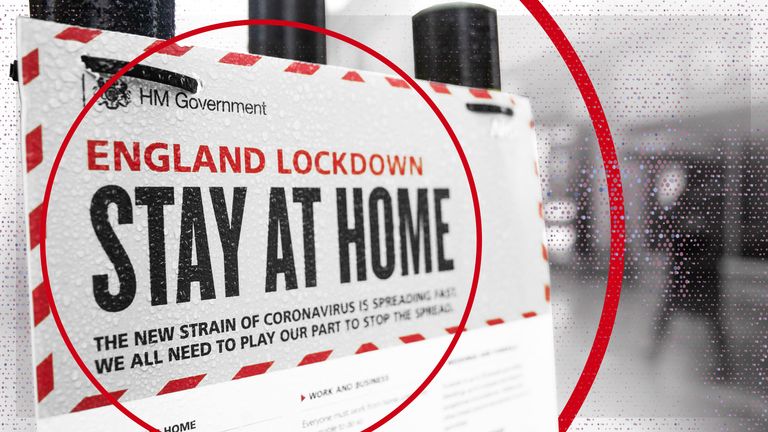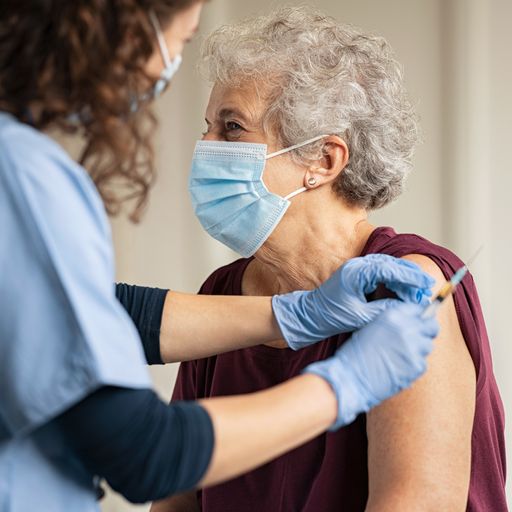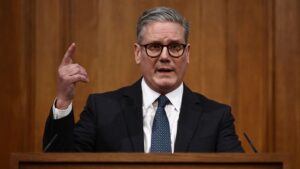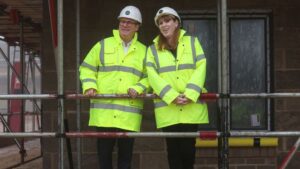COVID-19: How does Boris Johnson hope to avoid another winter lockdown?
The prime minister is pinning his hopes on the UK’s vaccination programme greatly reducing the threat of COVID-19 this winter, when there are more favourable conditions for coronavirus and other seasonal viruses.

Almost two months on from “freedom day” in England – when most COVID-19 restrictions were scrapped – the government has set out its plan for what scientists fear could be a “bumpy” winter for the NHS.
Last year, an autumn surge in COVID infections saw England enter a second and then third national lockdown in an effort to dampen the growth in cases and prevent hospitals from becoming overwhelmed.
However, since then, more than 80% of over-16s in the UK have now received two doses of a coronavirus vaccine.
Prime Minister Boris Johnson is pinning his hopes on the vaccination programme greatly reducing the threat of COVID-19 this winter, when there are more favourable conditions for coronavirus and other seasonal viruses.
And – despite the potential return of mandatory face masks, home-working and the possible introduction of vaccine passports – the government’s “autumn and winter plan” for dealing with COVID includes few of the social and economic restrictions that Britons grew used to throughout 2020 and 2021.
Ministers are also insistent that another coronavirus lockdown would be an “absolutely last resort”.
What is the COVID situation now? And why is there a need for a winter plan?
The current number of daily COVID cases is around 30,000 with around 1,000 COVID patients a day being admitted to hospital.
This is significantly higher than the level that daily cases and hospitalisations were running at 12 months ago, ahead of last autumn and winter.
There are also fears that, with fewer restrictions in place this year, other infections such as norovirus, RSV (respiratory syncytial virus) and flu will make an unwelcome return this winter to increase pressures on the NHS.
By contrast, the lockdowns of 2020 and 2021 dramatically reduced the prevalence of other infections, as well as pushing down the number of COVID cases.
As England’s deputy chief medical officer Professor Jonathan Van-Tam has warned: “We know that this pandemic is still active, we are not past the pandemic, we are in an active phase still.
“We know this winter could be bumpy at times and we know that winter viruses such as flu and RSV are highly likely to make their returns.
“So with that in mind, the aim of the game – the mantra – is to stay on top of things.”
However, there are also significant reasons to be positive ahead of the autumn and winter months.
Public Health England has estimated that more than 112,000 deaths, 143,000 hospitalisations and 24.5 million infections have been prevented so far as a result of the UK’s COVID vaccination programme.
Figures from the Office for National Statistics also show that almost 99% of COVID-19 deaths in the first half of this year were people who had not received both doses of a vaccine.
What is the PM’s plan A?
The government aims to avoid the return of stringent COVID restrictions this winter in a number of ways.
Vaccines:
Primarily among ministers’ plans are continuing and expanding the UK’s vaccination programme.
This includes encouraging those who are eligible to get jabs, but have not yet been vaccinated, to take up their offer.
There will also be an expansion of the vaccination programme to 12-15-year-olds, and the offer of booster jabs to the most vulnerable, frontline health and social care workers, and all over-50s.
Meanwhile, separate to the booster jabs programme, the NHS will continue to offer a third vaccine dose to people aged 12 and over with severely weakened immune systems.
Antiviral drugs:
Ministers will work with the NHS to ensure that a newly-approved antibody cocktail – as was partly used to treat former US president Donald Trump – is rolled out to patients as soon as possible.
The government’s Antivirals Taskforce, launched by the prime minister in April, will also continue its search for other new antiviral drugs.
Testing and self-isolation:
The government’s winter plan describes NHS Test and Trace as “critical” to managing COVID during the upcoming months.
Contact-tracing will remain throughout autumn and winter and ministers will continue to encourage the use of the NHS COVID-19 app.
The legal requirement to self-isolate for 10 days if you test positive for COVID-19 will remain in place, with PCR tests continuing to be available free of charge.
Lateral flow tests for asymptomatic testing will also continue to be provided, while ministers expect regular COVID testing to continue for secondary school, college and university students for the rest of the current term.
Financial support will continue to be provided for those self-isolating, if they are eligible.
More cash for the NHS:
The government has already announced that an extra £5.4bn will be given to the NHS to support its COVID-19 response over the next six months.
Care homes:
From 11 November, anyone working or volunteering in a Care Quality Commission-regulated care home will be required to be fully vaccinated.
Flu jabs:
Ministers want as many people as possible to get a flu vaccine this year, with free jabs available for all school children, all over-50s, pregnant women, and vulnerable groups.
Fresh air and face masks:
Ministers will continue to encourage people to let fresh air in should they meet others indoors, and to wear face coverings in crowded and enclosed settings where they mix with people they don’t normally meet.
Businesses are also encouraged to ask employees to stay at home if they are feeling unwell and, by law, are banned from asking workers to come in if they are self-isolating.
Some £25m will also be spent in providing around 300,000 carbon dioxide monitors for schools in order to assess ventilation levels.
New travel rules:
The government will also continue to impose border restrictions on those travelling to or returning to the UK.
New travel rules, which could include revisions to the current traffic light system, are promised before 1 October.
And if that doesn’t work, what’s plan B?
In their winter plan, ministers admit that their plan A might not be enough to prevent “unsustainable pressure” on the NHS.
As a result, a series of contingency measures have been set out in a plan B for this winter.
Government messaging:
Ministers have said they will communicate clearly and urgently with the public should the level of risk from COVID-19 increase and they need to urge more cautious behaviour.
COVID vaccine passports:
Under plan B, the government has also set out the possibility of introducing mandatory vaccine certification – commonly known as vaccine passports – in England in some settings.
These would be nightclubs, indoor music gigs or other similar events with 500 or more attendees, outdoor festivals or events with a crowd of 4,000 or more, and any settings with a crowd of 10,000 or more, such as football matches.
Ministers had previously planned to make proof of two doses of a COVID-19 vaccine a condition of entry to nightclubs and other crowded venues in England by the end of September.
They have since scrapped those plans but have made clear the use of vaccine passports – without the alternative of showing a negative test result – could yet be a condition of entry to some venues this winter.
Ministers have promised at least one week’s notice before mandatory vaccine certification are enforced.
The use of COVID vaccine passports is already due to be introduced in Scotland for over-18s for nightclubs and mass events.
Mandatory face masks:
The government has said, under plan B, it could also reintroduce the legal requirement to wear face coverings in some settings.
Prior to 19 July, people in England who did not have a medical exemption had to wear face masks in shops and on public transport.
Work from home:
Ministers have also said they could reintroduce the command for people to work from home, if they can, under plan B in a bid to reduce COVID transmission rates.
But the winter plan suggests it is not a favoured measure as it states: “The government recognises this causes more disruption and has greater immediate costs to the economy and some businesses than the other plan B interventions, so a final decision would be made based on the data at the time.”
Is plan B likely?
A work from home order could be reimposed by the government without a fresh vote in the House of Commons.
However, the mandatory wearing of face coverings and the introduction of COVID vaccine passports – two measures that are unpopular with some Conservatives – would require MPs’ approval.
A political row over the introduction of COVID vaccine passports in England would certainly be expected.
So there won’t be another lockdown?
Although ministers have said they expect their plan B contingency measures to be “sufficient” to reverse a resurgence in COVID-19 this autumn and winter, they have not given a guarantee that there won’t be further action.
But they have said that “more harmful economic and social restrictions would only be considered as a last resort”.
Another national lockdown does seem unlikely at this point as, under a six-monthly review of the Coronavirus Act, the government has promised to ditch a number of its powers.
These include its ability to shut down whole sectors of the economy and types of businesses, the power to temporarily close schools, and the power to restrict or ban gatherings.
Some of the only legal powers remaining to ministers include the ability to require people to self-isolate, powers for local authorities to respond to an imminent threat to public health i.e. to shut down a particular venue, and powers that allow ministers to provide extra support to the NHS and provide financial support to those forced to self-isolate.
No legislation will remain in place to allow local or national lockdowns, so the government would have to ask MPs for fresh powers if they wanted to go further than their plan B.




